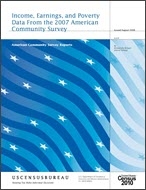Income, Earnings, and Poverty Data From the 2007 American Community Survey
Income, Earnings, and Poverty Data From the 2007 American Community Survey
Introduction
This report presents data on income, earnings, and poverty by detailed socioeconomic characteristics for the United States, states, and lower levels of geography based on information collected in the 2006 and 2007 American Community Surveys (ACS). A description of the ACS is provided in the text box “What Is the American Community Survey?”1
The U.S. Census Bureau also reports income, earnings, and poverty data based on the Current Population Survey Annual Social and Economic Supplement (CPS ASEC). Following the standard specified by the Office of Management and Budget (OMB) in Statistical Policy Directive 14, the Census Bureau computes official national poverty rates using the CPS ASEC and reports the 2007 data in the publication Income, Poverty, and Health Insurance Coverage in the United States: 2007.
The 2007 ACS is the second year of the survey’s implementation including both housing units and group quarters in its sample.2 The ACS is designed to provide detailed estimates of housing, demographic, social, and economic characteristics for the states, counties, places, and other localities. This report makes state-level comparisons over the 2006 to 2007 time period. Such comparisons should be interpreted with caution because of overlapping income reference periods.3
Additional historical trend data on median household income and poverty from the CPS ASEC are available on the Internet.4
The Census Bureau also produces annual estimates of median household income and poverty for states, as well as for counties and school districts, as part of the Small Area Income and Poverty Estimates program (SAIPE). For more information about estimates for smaller geographic areas, see the text box “Additional Source of State and Local Estimates of Income and Poverty.”
This report has three main sections: household income, earnings of men and women, and poverty. The income and poverty estimates in this report are based solely on money income received (exclusive of certain money receipts, such as capital gains) before deductions are made for items such as personal income taxes, social security, union dues, and Medicare. Money income does not include the value of noncash benefits such as food stamps; health benefits; subsidized housing; payments by employers for retirement programs, medical, and educational expenses; and goods produced and consumed on the farm.
__________
1 The text of this report discusses data for the United States, including the 50 states and the District of Columbia. Data for the Commonwealth of Puerto Rico, collected with the Puerto Rico Community Survey first introduced in 2005, are shown in Tables 2, 5, 6, and 10; in Appendix Tables A-1, B-1, and B-2; and in Figures 1, 2, 3, 4, and 5.
2 From 2000 to 2004, the ACS was in the demonstration phase, which consisted of a housing unit sample of approximately 800,000 addresses per year and produced estimates for the United States, states, and essentially all places, counties, and metropolitan areas with at least 250,000 people. In 2005, the ACS went to full implementation with its sample of housing units. The 2005 ACS produced annual estimates for the United States, states, and all places, counties, and metropolitan areas with at least 65,000 people. The 2006 and the 2007 ACS samples also included people in group quarters. For guidance on comparing 2007 ACS data with 2006 ACS data and data from other sources, see <www.census.gov/programs-surveys/acs/guidance/comparing-acs-data.html>.
3 As described in the text box “How Is Income Collected and Measured in the 2007 ACS?” the reference period for income data collected in the ACS is the past 12 months. As ACS data are collected in every month of the year, adjacent years have some reference months in common. Hence, comparing the 2007 with the 2006 estimates is not an exact comparison of the economic conditions in 2007 with those in 2006. Although the ACS will show trends over time, precise year-to-year comparisons are difficult to interpret. For a discussion of this and related issues, see Howard Hogan, “Measuring Population Change Using the American Community Survey,” Applied Demography in the 21st Century, Steve H. Murdock and David A. Swanson eds., Springer Netherlands, 2008.
4 See <www.census.gov/topics/income-poverty.html>.
Others in Series
Publication
Publication
Publication






